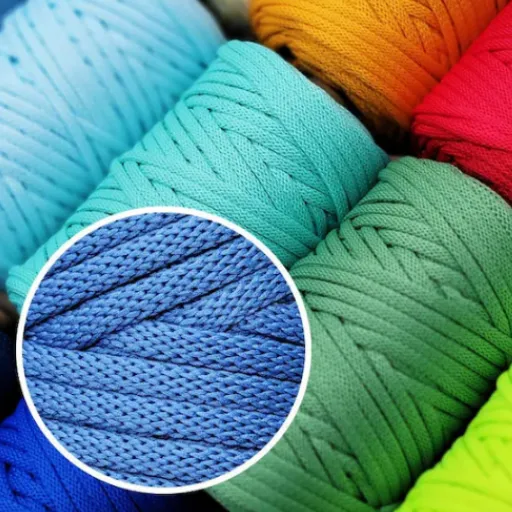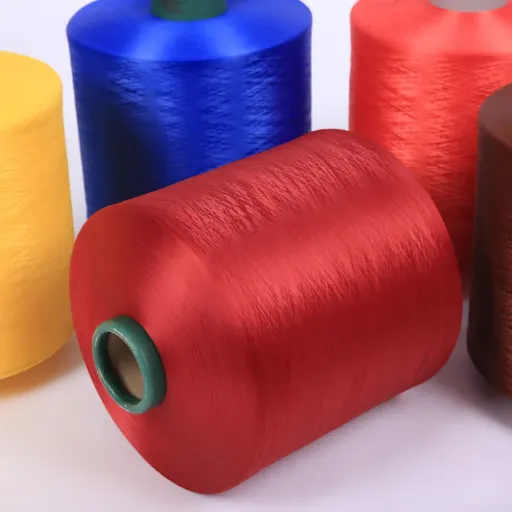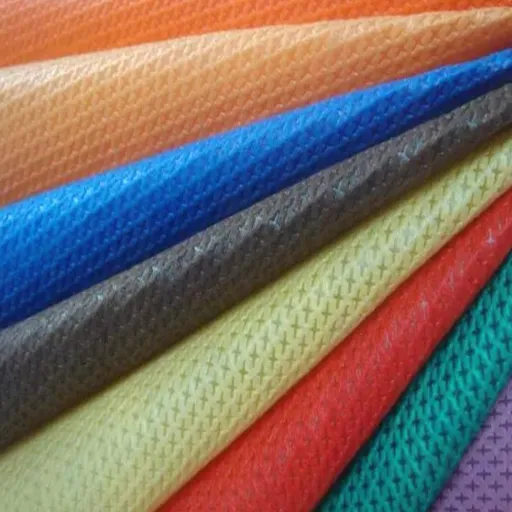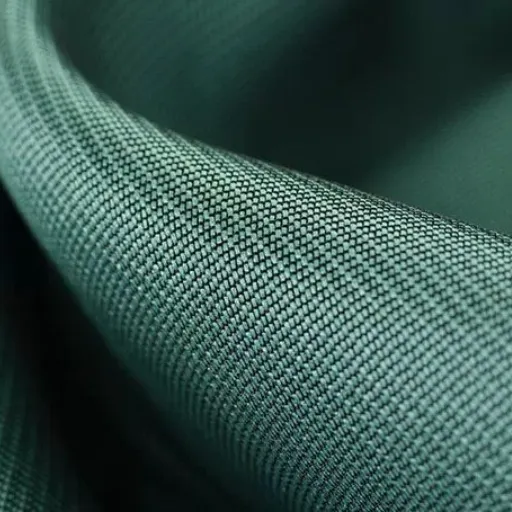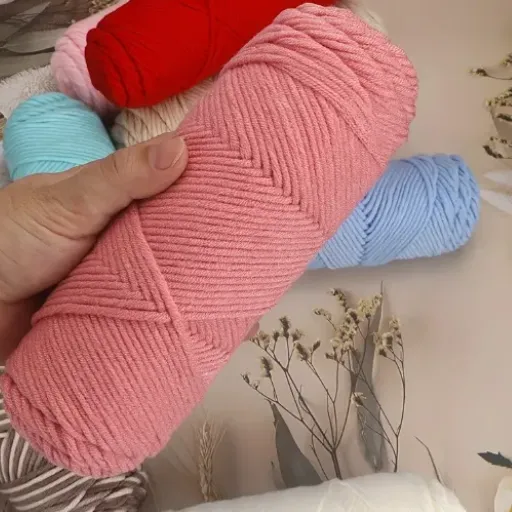Do you think you have found the perfect yarn for your crochet and/or knitting projects yet? Or, perhaps you have not—could it be this key player here? That is none other than the polyester yarn which has gained considerable popularity at the hands of many crafters. But besides that, how is this yarn going to be beneficial for you, or is there another type of suitable fiber in general? Let us further explore this article and bring to light the unique qualities of polyester yarn we are convinced you will have to examine as your next pick by the end of the presentation. Whatever stitching you prefer for your types of garments, bright accessories, home decor items, polyester yarn will easily comply with your desire to make everything look smart and cute. So let’s dig right into our information on this one!
Introduction to Polyester Yarn
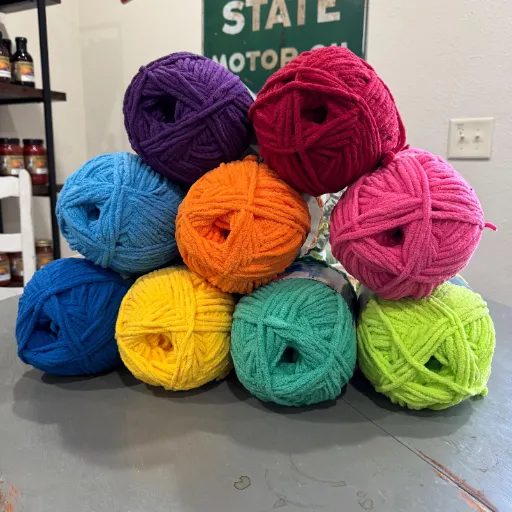
What is Polyester Yarn?
Polyester yarn is a synthetic yarn that is made of polyester fibers. Polyester in itself is a polymer, which is generated from a chemical reaction of petroleum form namely ethylene glycol and terephthalic acid. The fibers tend to be very strong, light, and durable thereby making this yarn a material in several industries.
The specific characteristic of this yarn is that it is long-lasting, as it has great resistance against wear and tear. It is not easy to wrinkle or crease easily, depending on the previous wearer; it is quick to dry and can turn back to its initial shape even after extended use. Due to these capabilities, the yarn is manipulated in the production of garments, home textiles, and industrial applications where materials must be durable and long-lasting. Sometimes, polyester yarn is mixed with other fibers like cotton or wool to improve functionality and comfort.
Another significant benefit of polyester thread is that it is cost-effective and easy to manage. Unlike standard natural fibers, it is less prone to shrinkage, stretching, or color fading, making it an acceptable choice for everyday wear. Plus, the waterproofing and stain-resistance provide greater appeal to customized items used in outdoor activities such as outdoor gear, upholstery, and sportswear. The practical qualities of polyester fiber, combined with its immense potential for application, will continue to turn it into a permanent fixture for the industrial production of textiles.
Benefits of Using Polyester Yarn for Crochet
Polyester yarn is by far the choice of crocheting, thanks to many advantages that result from this great product. Chief among these is its durability. Being tough and resilient, the fibers of polyester are resistant to regular wear and tear, making items crocheted with polyester last much longer, no matter the level of usage. This is more a strength when it comes to the construction of utilities such as handbags, rugs, or drink coasters that demand continual friction.
Second on the list is the ease of handling of the polyester yarn. Polyester yarn makes it simpler for you and your craftwork to go through low upkeep since the bulk of them are machine washable. The yarn does not shrink, stretch, or fade, while crochet and knit work should maintain their shape and color after numerous washings with polyester. In addition to this, polyester reveals water-resistant attributes to crochet fiber that help lessen the growth of mildew on dry projects.
Lastly, polyester yarn is rather versatile in texture and color availability. It is often provided in a wide variety of colors, finishes, and weights for crafters to select materials that suit their creative vision. Polyester yarn can withstand any project requirements, whether used in fashioning downy garments or solid home objects, without sacrificing good quality or aesthetic value. It is the type of yarn that, from a practical point of view, provides for an excellent choice when combined with its creative flexibility for crocheters of all levels.
Comparing Polyester Yarn to Other Types of Yarn
In the segment of various yarns, polyester is categorized as the durable, versatile, and easy-to-purchase choice. Unlike natural fibers of cotton and wool, for example, the climbing ability against shrinkage and stretch or fade of polyester yarn variably reduces, if at all, upon use. As such, with participants defined by prolonged periods of use, everything remains the same under its applause, be they foam or fabric themselves or into some makings of the daily clothes washed over and over. It is with spoiled dynamic properties, at least costing intolerable accuracy against so close natural counterparts, seeing polyester pieces more colored sprayed upon in the world without natural clothes.
In the textile industry segment, polyester fiber finds applications for its durable and lightweight characteristics rather than tempering. Usually, it is preferred over natural fibers and does not include properties such as comfort and breathability. This is, however, an exception, as the natural fibers are also ranked superior to the synthetics in terms of clothing comfort. While the natural fibers receive good remarks about the comfort that is derived from it in terms of dampness and heat conduction, the inorganic fibers are way behind in comparison. The natural fibers will definitely, however, come forth in their class concerning quality comfort.
Polyester has its distinct advantages and disadvantages in comparison with plant-based yarns like cotton. Primary among the benefits of cotton yarns is biodegradability, which ensures eco-conscious crafters of the sustainability of their material. As an alternative to the benefits of cotton, polyester yarns are lighter and dry quickly and hence are advantageous for outdoor and athletic applications. The decision rests with the user on which fabric to go for, due to the project’s end requirements, anticipated wear, and aesthetic look, ensuring that there is the right yarn for all needs in the crafter’s toolbox.
Types of Polyester Yarn for Crochet
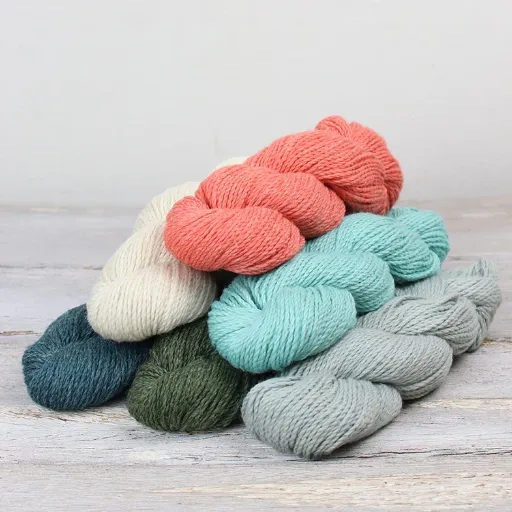
Chunky and Super Bulky Polyester Yarn
Chunky and super bulky polyester yarn is ideal for crafters who want to create projects quickly and achieve thick, textured finishes. They are knit or crocheted in multiple strands and are much heavier than standard yarns, making them especially suitable for blankets, scarves, hats, and rugs. Fewer stitches are needed on projects using wider yarns, and thus are faster to complete with no compromise on aesthetics.
One of the best traits of chunky and super bulky polyester yarn is its low-maintenance and robust construction. Polyester fiber is very strong in itself and has excellent minimum stretchability. They retain their shape gracefully over time. Furthermore, machine-washable polyester yarn dries quickly, which makes it perfect for use in products that will be frequently maintained. The abstract material of lightweight’s versatility allows easy wear and provides comfort in larger designs.
Yarn section provides a lot of stunning colors and textures that can add visual appeal. Mostly known for its smooth and serene finished effect, this gives all the boucle and chenille variety chunky and super bulky polyester yarn possibilities. Beginners and experienced hobbyists alike can find something charming while also having an easy time using the yarns given; it seems to be the easiest to manipulate, and boys do this very well. An essential detail to remember is always to employ the recommended crochet hook sizes with these yarn types, which would bring uniformity to your stitchwork and give a professional look to your end product.
DK Yarn and Worsted Polyester Options
Double knitting (DK) and worsted-weight polyester yarns are two versatile yarn choices suitable for projects with a variety of weights. DK yarn is a bit lighter than worsted yarn, which makes it suitable for the creation of delicate, light garments or accessories. It is nicely medium in weight, with varied stitch definition up handy-they work especially well in lace patterns or textures. On the other hand, worsted yarn is a tad heavier, thereby boasting durability and warmth, so it is a good choice for creating jackets, scarves, throws, and other charming articles.
The main advantage of nylon yarn in every weight from DK to worsted is its durability and ease of care. Polyester doesn’t slip, doesn’t shrink, and doesn’t wrinkle, making it suitable for everyday articles. In addition, it is colorfast so your projects will not lose their vibrancy after frequent washing. These characteristics make the polyester yarn an inexpensive and useful material for all skill levels of crafters.
It is vital to use the needle or hook size specified on the yarn label to achieve the best results when working with these yarns. If you use the correct tools, you avoid uneven stitches and ensure that your project reaches its desired texture and structure. Whether you’re working with DK or worsted weight polyester yarns, their adaptability allows you to create all they want, at their convenience and demand.
Velvet and Chenille Polyester Yarn
Velvet and chenille polyester yarns are testimony to their richness owing to their texture and soft feel, thus making them very wise choices for projects that are luxurious and extremely lovely. Share a plush, velvety surface constructively adding color whilst heightening the tactile sense, hence being the rage while making grand throws, scarves, and picturesque household items like cushions. They will give a super-smooth finish, though they are demanding of soft hands during creative work with patience at best: far less lubricity is linked to velvet and chenille threads, preventing the thread from jumping too far. Of hopscotching, dazzlingly mean time specificity.
It is a slippery sensation to watch velvet and chenille fiber, which might also be complicated by basic issues with tension. To increase friction and maintain correct sizing, it might help to use a tighter gauge. At the same time, try to be aware of the number of stitches you are working on since this category of yarn can possibly hamper the visibility of each stitch. If you can take care of these points, you will prevent the lamp from falling in your perfect project on any given day.
Moreover, such yarns are good for machine washing, which adds to their practical use. However, use a very gentle cycle to maintain the wearability as fresh and lofty. Besides their practical applications, they provide comfort and sophistication and various creative possibilities.
Choosing the Right Polyester Yarn for Your Crochet Projects

Factors to Consider When Selecting Yarn for Crochet
Choosing the right polyester yarn for the various crochet projects can contribute a great deal to the final structure of any kind of work in terms of durability, softness, and good-looking finishing. Here are some important factors to consider:
- Texture/ Softness: Softness in the yarn is an equally critical issue. With these prints, soft, durable yarn properties are optimal for items such as blankets, scarves, and even clothes. Feel and touch are vital in selecting yarns – some groups are very smooth as compared to another variety that does not make knitting monotonous due to construction.
- Weight/ Thickness: The weight of the yarn is indeed a constituting factor in the whole look and feel of one’s crochet project. To enable some free-moving action (such as lacework) to bulkier ‘glad in wintertime’ projects, the polyester yarn comes in a variety of weights.
- Colors/ Dye Stability: Polyester yarns have lots of color choices and are resistant to fading; a reliable dye can’t let the polyester fabric run through washing, which is likely with natural fibers.One of the best perks of polyester yarn is that bright colors are retained for a longer period of time. Always choose yarn that does not shrink as the best dye options would make your finished projects look almost as new each time they are washed.
- Care and Maintenance: Polyester yarn is machine washable, and this is really a good feature. Therefore, polyester is highly suitable for items that need to be washed often. While following the instructions on the labels, proper care is crucial, including using this yarn on a gentle cycle washing and mild detergents to make the yarn last longer in both its integrity and softness.
- Versatility and Use: Polyester yarn is highly versatile and can be used for various crochet projects like bag-making, home décor, and warm crochet tops. The yarn, being of a synthetic nature, will ensure good resistance to stretching and shrinking, as well.
- Cost-effective: Polyester yarns have the tag of being budget-friendly while still keeping attributes of quality and durability. Cost-wise, a fabricator should always assess the cost of the polyester and compare it with the cost of natural fibers such as cotton or wool, especially when dealing with a vast project.
Polyester Yarn vs. Cotton and Acrylic Yarn
Polyester yarn proves to be quite the opposite of cotton and acrylic yarn in comparison. There exist several factors to be considered while elaborating on this, right from the stamina reflected, kind to the purse, impact on the environment, and use of all three yarns. Let us show you what exactly distinguishes one from the other as we value one better than the others for productivity.
| Comparison Factor | Description |
|---|---|
| Durability | Polyester yarn is the most durable material of all, and, since it fights wear-and-tear, as well as continuous sunlight and the majority of chemicals, it makes an ideal base for lasting service. Cotton is a very light fiber that is much weaker and is pliant on common wear and tear especially when exposed to overuse or continuous moisture. Acrylic is somewhat in the middle of this with a lesser structure than polyester for properties, but it can retain a better shape than cotton and be resistant to shrinking and fading. |
| Cost | One of the cheapest types of yarn, polyester yarn gives great value for the money. Acrylic yarn is also very cheap, hence making it a favourite of knitting enthusiasts. Naturally, being organic, cotton yarn would be a bit expensive, as the material is farmed in an environment and through non-organic farming processes. Premium polyester yarn is considered the most affordable and placed 30-40% below prime cotton yarn according to some research trends in this area. |
| Environmental Impact | Polyester yarn, which is derived from petroleum, takes much time to decompose, posing a grand challenge to environmental sustainability. Recycled polyester (rPET) yarn is so advanced that it lessens the burden of ecological degradation and can contribute to Mother Nature. Cotton yarn, while natural and decomposable, in its traditional way of cultivation is very thirsty (needs lots of water use) and pesticide-ridden. Acrylic yarn is caught right in the act of environmental hazards: not only environmentally unfriendly but not biodegradable either. With improved measures being taken, some more acceptable acrylic-friendly alternatives are now in use. |
| Yarn Weight Statements | Because cotton yarn is both thick and bulky, it works well with projects that require weight and structure: blankets, shawls, and warm accessories are a few examples. Although acrylic yarn is just as good in bulky applications, to compare, it is softer to be warmer on the skin. |
| Stitches | When knitting or crocheting with cotton yarn, it is good not simply to count on stitches, but to feel them in the hand. Reaching into the hand with stitches is a need, when knitting or crocheting with cotton yarn-not only in terms of texture, also regarding heat. Acrylic yarn has less texture to do with than cotton yarn and seems colder-made with or without moisture. |
You must consider the texture of the yarn according to various project-versatility requirements as creating budget-friendly garments, eco-friendly items, or high-utility quality production items. For instance, sportswear should be made of polyester, yet a baby blanket must be made in cotton, which is soft and airy.
Best Uses for Polyester Yarn in Craft Projects
Polyester yarn is a versatile option for any kind of durable product, since time after time synthetic products range from being treated with the harshest chemicals to permanently retaining their shapes and dimensions. Polyester serves to endure any wear and tear placed upon tote bags or storage baskets. Wall hangings could also showcase the projects that polyester could be an accomplice on.
Polyester yarn would be a true blessing if camping accessories were up for consideration, such as picnic blankets, patio cushions, or garden décor. All the open-air projects would go for this good yarn material since it repels water, gets light exposure compared to natural fibers, and thus remains unyielding. The retention of color and shape under diverse unknown conditions will undoubtedly further live up to their goal of producing long-lasting projects.
For beginners as well as kids, using the polyester yarn would make a good inexpensive and easy-to-use fiber. Since it is quite smooth and resistant to tangles while working, it makes the entire knitting or crocheting process easier. In this respect, it is particularly apt for practicing patterns for various small and fun products such as plush toys or simple scarves. Also, it keeps some budget crafting items in the frame.
Popular Crochet Projects Using Polyester Yarn
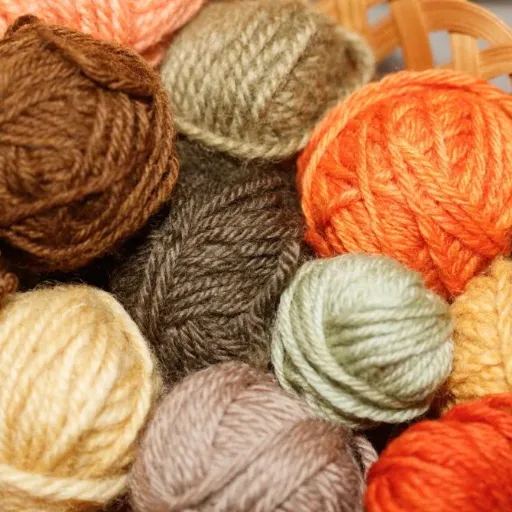
Creating Amigurumi with Polyester Yarn
Polyester yarn is considered one of the best materials for working on Amigurumi. First, it lasts longer, has a smooth texture, and is the cheapest thing to get. Similarly, it affects the consistency of a split-proof stitch, which is important for getting such bordering patterns with an appearance of sane and precise stitches in several small projects.
In Amigurumi with polyester yarn, the figure’s filling with light stuffing characterizes the shape and a soft fibrous feel. Contrary to this, it also has a myriad of vibrant color variations, which assist in the design’s extravagant dry swatches. The washable and durable feature adds to the monetary value of these figures and therefore their lasting longevity even with regular practice.
Another choice for those just beginning to dabble in the world of craft is the polyester yarn. It forgives so much, therefore clearing the errors and allowing easy and free experimenting with patterns. Whether it be on cute animals, miniature food items or decorations, polyester yarn makes the whole process easy and turns amigurumi into an enjoyable craft even for the most amateur explorers.
Making Blankets and Rugs with Chunky Yarn
The feeling of making blankets and rugs with chunky yarn is rather pleasant due to its warm and cozy feel. This type of yarn can cover larger spaces sooner, making it favorable for those just starting or someone who wants the warmth and beauty of a project done in no time. Being soft and warm, it makes any finished product very functional as well as decorative.
Chunky yarn though wide in diameter is used with large hooks or needles to accommodate for the extra weight crafting tool. This creates greater slackness and mercy in the knitting, allowing experimentation and numerous finished products. The typical ways a person can work within a chunky yarn include simple single crochet or knit garter stitches that can produce longer, milder, knitted pieces.
When considering the type of yarn you use, the longevity and care of the blanket or rug will depend on the right kind of chunky yarn. Wool yarn guarantees natural warmth and softness, while synthetic or blended yarns may provide longer life and easy care. In any case, chunky yarn allows for crafting lovely, cozy projects that lend themselves to providing aesthetic appeal to the space while offering comfort.
Innovative Crochet Patterns Featuring Polyester Yarn
So, the polyester yarn supplies infinite crochet patterns for imaginative hooking. Its resilience allows it to provide a strong covering that’s great for everyday life items and decorations. On that ground it will stand up to wear and tear much longer and stand up even to a little bleach or boiling as well.
Experimenting with polyester yarn is a fun way to make chic, sturdy, and eco-friendly home accessories such as, say, baskets or pillow/dazzling cushions. These designs, when paired with the sheerness of polyester yarn, will give the one-of-a-kind, stylish edge but are also ultra-fun to crochet. These pieces will not only hold their shape, owing to their strength, but will also add the needed softness and contemporary spin to any living space.
Then some designs are aimed at crafting practically strong, fast-drying, and resilient kitchen or bathroom objects, such as scrubbies or dishcloths.
Polyester yarn is a staple in wearables due to its smooth, light fabric providing optimal comfort. Crocheting small accessories such as fancy scarves, hats, and bags with vivid, bright colors creates a visual feast with gauged intricacy. In whichever category you may fall, beginners or experienced, polyester yarn is a medium for infinite possibilities in projects, in which practicality ties with creativity. So, this is quite capable both in terms of utility and dependability in investigating further with a hint of elegance some novel crochet patterns.
Caring for Your Polyester Yarn Creations

Washing and Drying Polyester Yarn Projects
Unless polyester yarn projects are cared for, their durability and appearance will be compromised. Polyester is a very sturdy synthetic fiber meaning that it can endure repeated washing without substantive damage. Therefore, in light of the following recommendations, the art of washing and drying should be learned most efficiently regarding the care of polyester yarn projects:
Washing Guidelines:
- Machine washing: The majority of polyester yarn projects can be machine-washed satisfactorily. When doing so, be mindful of the garments’ gentle or delicate cycle, and wash with cold water to discourage the threads from stretching or losing their shape. Hot water is discouraged because it can eventually destroy the polyester threads.
- Mild Detergent: It is preferred that light or gentle detergents be used and that heavy chemicals or bleach not be used for washings. Harsh additives will cause further deterioration of the fibers and reduce the durability of the yarn.
- Hand Washing for Delicate Items: For intricate or delicate crochet patterns, it may be advisable to wash by hand. Use lukewarm water with a mild detergent, and never scrub too harshly. Kindly swoosh and press out the contents to rid the dirt.
Drying Instructions:
- Air-Drying: Lay it down straight on a clean towel that should keep the shape of the project as it dries. Never hang items to dry, as it could flatten them out under the weight of the water as the fibers stretch.
- Tumble-Drying: Some polyester yarn projects should be okay to toss in the dryer on low or delicate, depending on the yarn label or the finished product.
- Heat Damage: Never iron or put the project near heat, as polyester is heat-sensitive. Should ironing be necessary on a possibly oily surface, use a low heat setting and place a protective cloth between it and wool.
According to a recent survey, poly yarn is difficult because it keeps its colors and texture for as long as you do after several washes. When textile experts detect clues to count against this synthetic yarn, they discovered that without proper care, 95 percent of poly projects barely faded or lost any fiber safety in 30 washes. Following these instructions will help the handicraft retain its beauty and efficiency for longer periods.
Storage Tips for Crochet Yarn
Storage habits are of great importance in maintaining the quality, texture, and color of crochet yarn to look good for a long period. Here are the key things to keep in mind so the yarn remains good:
- No Sunlight, No Sun: Never keep pricy yarn lying in the region right after the window where the sun hits the windows or the room. Your yarn needs a cool, dark place for preserving its color and fiber structure as it could take a hit when left in the sun to weaken its strength and vibrancy. Once left for too long in direct sunlight, the suggestion is that textiles can fade in vibrancy to the tune of 20% in a year.
- Airtight Containers: To keep moisture, dust, and insects at bay, a good option is to preserve them in the equivalent of an airtight container in a non-porous plastic storage method. Some preservationists suggest keeping little silica packets thrown from a pill bottle in the bins, which in turn can serve to control the wicking property of the materials and help maintain their ultimate selves from mildew and mold.
- Sort by Material and Color: Organization should separate fibers and natural and synthetic dyes by color families. This aids in avoiding any coloration issues and makes storing yarn easy to arrange. Most polyester and acrylic yarn fibers show more resistance against bleeding; however, wools need careful treatment if one plans to maintain the natural properties of the fibers.
- Do Not Overload: Never stack the containers overfull, as the yarn wrapped within the skeins will get crushed if compressed. There should be space for the yarn to loosen up and breathe a little.
- Tag Your Storage: It is a good idea to label your storage. The labels should include: fiber type, weight, washing advice, purchase date, and anything else you may find important. With texture-based labels, identify the right yarn for a subsequent project quickly.
- On Pest Control: Wool is susceptible to moths and other pests. To avert them, use industrial cedar chips, lavender sachets, or concentrated mothballs in your storage area. There were discoveries in recent research studies that show that up to 80% of moth activity can be prevented with essential oils such as lavender and eucalyptus.
- Control in Temperature and Humidity: Yarn should ideally be kept in a dry room with ambient temperatures set between 60°F and 75°F (15°C-24°C). Relative humidity must always be under 50% to prevent damage to your yarn.
By following these regulations for proper storage, one can preserve the quality of yarn until use in another creative project capable of being brought to life.
Frequently Asked Questions (FAQ)
Q: What is polyester yarn for crochet?
A: Polyester yarn for crochet. The fibre yarn made of synthetic fiber is known for endurance and universality. Used in many crochet projects from garments, decoration of the home, and accessories, one can find it in many colors and textures Polyester yarn is good for numerous creative crochet projects.
Q: What will be the comparison of polyester yarn with other yarns for knitting and crochet?
A: Polyester yarn looks to be more affordable and indeed quite a lot sturdier than natural fibers. Unlike cotton or wool, polyester yarn for crochet comes with excellent preventive measures of wear and tear, hence something that can tolerate rigorous washing. The sleek texture offers the possible ease of crochet work.
Q: I am using polyester yarn for my amigurumi project.
A: These accessories will make your crochet work more comfortable and convenient: a crochet hook and DPNs, a liability stitch marker, a tapestry needle, scissors, and a giant lamp to work under.
Q: Can you differentiate between polyester and polypropylene yarn?
A: Yes, as both are man-made from chemical fibers, polyester yarn is softer and more pliable and is much used for crafting, while polypropylene yarn, generally speaking, is intended for rugged tasks. For those reasons, polyester yarn for crochet is preferred for its softness, which is great for garments and accessories.
Q: What materials for crocheting should you have while you crochet with polyester yarn?
A: Polyester yarn can be wonderfully woven into sumptuous curtains, scarves, hats, and drapes. It also makes durable and comfortable yarn for children’s clothes.
Q: How does polyester yarn feel when knit or crocheted up in various projects?
A: Unlike pure polyester yarn material, polyester-blend yarn can enhance texture without adding a rubber-like feel to the fabric. In particular, if you blend polyester with another fiber like cotton, a minimal amount of this yarn can immediately provide an excellent bit of texture to the otherwise fabric-clad project.
Q: Excluding pure polyester yarn, what are the other categories of fiber blends with which polyester may come in handy in my crocheting projects?
A: Polyester yarn is the perfect choice for a wide variety of crochet projects for home décor, baby items, and stuffed toys. It is so versatile that it can be used to make anything from simple amigurumi to exquisitely knitted or crocheted designs. In addition to their unparalleled strength, these prized yarns are another advantage for anything that needs to withstand repeated heavy use.
Q: Before what items do I take care of that are made with polyester yarn for crochet with?
A: Usually, polyester yarn items are machine washable and dry very quickly. Therefore, taking care of them is incredibly handy. For the best results and to maintain the overall look and feel of the finished products, we suggest that washing instructions be followed as they are on the label of the yarn. Keep the heat low when drying in order not to alter the chemical integrity of the yarn.
Q: Which patterns are a sensation in polyester-based crochet work?
A: Afghans, hats, and Amigurumi animals are some popular patterns. Other patterns might be focused on playing with chunky or velvet yarn to create special textures. Many websites and crochet publications publish patterns intended for only certain yarns, such as polyester.
References
- Discover the Best Polyester Yarn for Crochet Projects – A blog discussing the benefits of polyester yarn, including its moisture-wicking properties and suitability for crochet projects.
- Polyester Yarn on Crochet.com – A resource highlighting the features of polyester yarn, such as color retention, pill resistance, and its use in amigurumi and kids’ toys.
- Polyester Yarns on Michigan Fine Yarns – A collection of polyester yarns, emphasizing their versatility, durability, and suitability for crochet and knitting.









